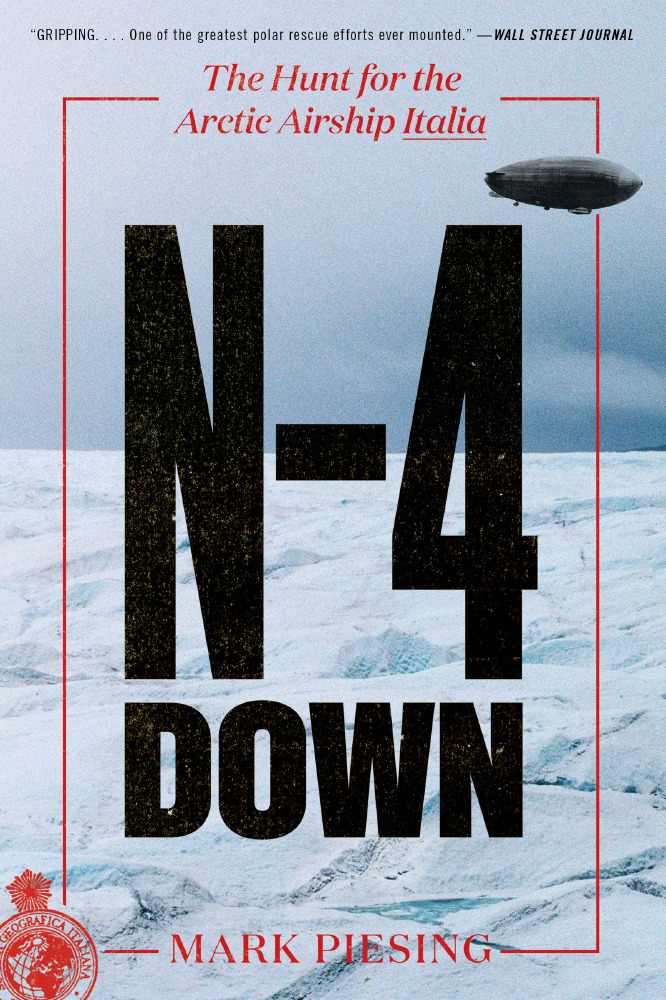In this exclusive for Femalefirst Mark Pieser reveals some amazing and shocking facts about his book N-4 Down you will be enthralled amaed and shocked - read on

Author Mark Piesing
Roald Amundsen was perhaps the greatest polar explorer of all time. In 1905 he became the first man to successfully navigate his way through the Northwest Passage, the sea route from the Arctic to the Pacific Ocean. That heroic feat was surpassed six years later when he beat the British hero Robert Falcon Scott to the South Pole in 1911. Scott and his four companions died on the return journey.
In 1925, Amundsen – together with the American millionaire and coal magnate Lincoln Ellsworth – decided to fly to the North Pole in an airship. Italian engineer, Umberto Nobile, had the only airship in Europe suitable for the flight. Nobile didn't look like the typical polar explorer. Born in the shadow of Vesuvius, near Naples in southern Italy, he was a descendant of one of the aristocratic families that had been close to the Bourbons, the ruling family of southern Italy. Nobile oozed a quiet confidence, bordering on cockiness. The engineer's unravaged good looks and smart military uniform were evidence that he had spent many years with his wife and daughter in Italy, rather than alone on the polar frontiers. But, there was something else lurking behind his apparent confidence: fear. In 1923, 30,000 of Benito Mussolini's Blackshirts marched on Rome and intimidated the Italian king, Victor Emmanuel III, into appointing their leader prime minister. Within three years, Mussolini made himself dictator, anointing himself ‘Il Duce’ – The Leader.
The Amundsen-Ellsworth-Nobile Expedition joined multiple engineers and explorers in the race to be the first to fly from Norway to the North Pole, across the shaded area on the map labelled ‘unexplored’, and then on to Alaska, in what the newspapers called ‘the most sensational sporting event in human history’. It was a competition that the Amundsen-Ellsworth-Nobile expedition won on May 14, when the airship Norge, designed, built, and piloted by the Italian, landed in Teller, Alaska. The New York Times headline read ‘NORGE SAFE IN ALASKA AFTER 71-HOUR FLIGHT’, devoting three pages to the story.
However, all was not well onboard the Norge. Tensions between Amundsen and Nobile exploded when the Norwegian realised that the thousands of Americans lining the quaysides and packing train stations were not cheering for the elderly explorer, but for the brave, good-looking Italian captain who had flown the craft: the man they were calling the ‘new Columbus’. It was a victory that made Nobile more of a target for his enemies in Rome, particularly for the Blackshirt’s leader Balbo. When he told Mussolini of his plans for a second flight, Il Duce warned him: “Perhaps it would be better not to tempt fate a second time.” Balbo requested two or three seaplanes as backup to help rescue the crew in case of a crash on the ice.
Nobile’s second exhibition was to take him to the North Pole on the airship Italia – code-named N. It launched on 23 May 1928 from Svalbard, 500 miles from the North Pole. The flight was to be the pinnacle of his career, certainly in the eyes of the world's press. The sun glinted off the envelope of the airship as it rose majestically over the mountains and headed north, a vision to those on the ground of the future of Arctic exploration.
Fact No. 1: Half of the crew were never seen again
The Italia hit the ice at 10.33am on May 25 and, remarkably, it survived. Only the control cabin under the airship had smashed into the ice; the rest of the craft was still intact. Out of control, it slowly rose skyward. Nobile and the other survivors on the ice could make out the remaining crew staring down through the gaping hole where the cabin had been. The astonishment on their faces turned to horror as they realised their fate. The six men were never seen again.
Fact No. 2: Roald Amundsen's death wish
Amundsen's reply to the request on 26 May to look for Nobile was simple: "Tell them at once that I am ready." It is hard to know why he so readily agreed to help, given their bitter, public falling-out. Of course, there were the rules of honour. And there was the glory. Perhaps it was the thought of a delicious final victory over Nobile, but there may have been a darker motivation too. Amundsen had recently had a cancer operation and needed radiation treatment. He sold off his collection of medals and honours and gave away his treasures. On the eve of his departure, Amundsen pointed at a model plane hanging from the ceiling and confessed, "That's where I want to die, and I wish only that death will come to me chivalrously, will overtake me in the fulfilment of a high mission, quickly and without suffering".
Fact No. 3: Amundsen died searching for Nobile
At 4:00pm on June 18, Amundsen's plane raced across the harbour at Tromsø. It was seen by fishermen as it disappeared into a fog bank 40 miles out to sea. That evening two radio messages were received, including the mysterious, "Do not stop listening. Message forthcoming." Whatever that message was, the operator never sent it. Later, a faint SOS was heard that may have been from Amundsen's plane.
Fact No. 4: Umberto Nobile abandoned his men
Around 11.00pm on the evening of 23 June, Swedish pilot Lieutenant Einar Lundborg's plane clattered across the ice. Dirty, unkempt, and sick-looking survivors ran to meet him.
"General, I have come to fetch you," Lundborg told the badly injured Nobile. But Nobile refused to leave. Lundborg informed the general that he had orders to bring him back to co-ordinate the rescue operation. Nobile must have known that the departure of the commanding officer before his men was at odds with protocol and tradition. But he persuaded himself that it needed far more courage to go than to stay. "I am ready," he said.
Fact No. 5: Nobile was betrayed by his government.
The moment Nobile was carried aboard the Italians' base ship he realised that Lundborg had no orders to bring him back first. Injured, confused, and emotional from a month out on the ice, he made another mistake, giving in to pressure to write an apology to Mussolini. This note would be used by his enemies to prove his cowardice. The Fascists then built a prison around him. Armed police, seemingly posted outside his cabin to protect him, turned out to be wardens who had another job: to stop Nobile from leaving. His communication was restricted. He was barred from helping with the rescue operations and he was not allowed to see the newspapers, in which his own government defamed him.
Fact No. 6: Woman Joins Arctic Search
Nobile had been found, but Amundsen had disappeared. The search for the great explorer began to gain momentum. Then came the news that shocked the world: ‘Woman Joins Arctic Search’. Millionaire Louise Boyd's luggage may have been designed for her by Louis Vuitton himself, but she was no stranger to the Arctic. Two years earlier, she made history when she became the first woman to organise, pay for, and lead an Arctic expedition. In the end, Boyd, like the rest of the would-be rescuers, found no trace of the old explorer, despite sailing for ten weeks in search of him. She became the first non-Norwegian national to be awarded Norway's highest medal. Few clues as to Amundsen's fate were found. One of the wing floats of his flying boat was recovered. Then, a fuel tank with a mysterious wooden bung in it. The search continues: expeditions using robotics still scour the seabed for Amundsen's grave.
Fact No. 7: Cannibalism
At exactly 5:20pm on 11 July, the lookout shouted: ‘There they are!’ The crew of the Russian icebreaker Krassin thought they'd found the three survivors who, over a month earlier, had set off on foot to get help: Mariano, Zappi and Malmgren. But of Malmgren there was no sign. The medics feared Mariano wouldn't live long; he was racked by fever, starvation, and frostbite. But his greatest fear had been that he would be killed and eaten. "When I die you can eat me, but not before," he is reported to have said. On the other hand, Zappi was able to walk back to the ship unaided, and underneath his own sodden garments he appeared to be wearing Malmgren's clothes. The press quickly picked up on the story. ‘Mystery about Malmgren's body gives rise to reports of cannibalism,’ reported one newspaper.
The main wreckage of the Italia was never found. No expedition was launched to find them. The only clue to their fate was a column of black smoke that was seen for a while far to the north. In the wreckage of the control cabin, the only part of the airship to have smashed into the ice, the survivors found one of the mechanics bent double, as though tying his shoelace. When he didn't respond, they shook him slightly. He toppled forward and rolled faceup. His face had been crushed by impact. He was dead.
Nobile's decision to leave his men on the ice would destroy his career and haunt him for the rest of his life. No sign of Malmgren's body has ever been found. Mussolini later agreed to pay his mother a pension. The suggestion by a Soviet scientist that Amundsen's frozen body, if found, could be brought back to life, was fortunately never put to the test. In 2012, DNA tests were used to disprove two Inuit men's claims that their father was Amundsen's son. The remaining survivors of the Italia were rescued by the Soviet ice breaker Krassin three weeks later. Tragically, three more aviators who had joined the search for Nobile and his men died on their way home. Nobile and the seven other survivors returned to face Mussolini. Louise Boyd became respected as a serious scientist, leading four more expeditions to the Arctic. Like Amundsen, her nickname was ‘The Chief’.
During World War Two, Boyd would be sent on several secret missions for the US military in the Arctic. She would die penniless. Her fortune spent on exploration. Her ashes were scattered in the Arctic. The graves of the 14 dead crew members and their rescuers who died in the Arctic have never been found. Some believe that the melting ice caps will reveal their location.
About the author
Mark Piesing is a successful freelance technology and aviation journalist and author. He writes for brands such as BBC Future, The Guardian, Wired, and The Economist. Piesing is passionate about aviation, history, innovation, and exploration. His passion has led him to search for lost World War II airfields in the New Forest, find the last surviving Nazi helicopter, fly drones inside a fusion reactor (a world first), and tread carefully around Bosnian minefields. He has been driven by an autonomous car, flown in Britain’s flying laboratory, gone underground at CERN, and dug up the skeletons of gladiators in a lost Roman city in Spain. For Piesing’s first book, N-4 DOWN: The Hunt for the Arctic Airship Italia, he travelled to frozen Svalbard and the Arctic Circle, discovered forgotten manuscripts in an overlooked archive in Tromsø, and tracked down one of the last people alive who knew Umberto Nobile, the protagonist, to a Copenhagen suburb. Mark Piesing lives in Oxford, UK, with his wife, two children, and dog.
N-4 Down: The Hunt For The Arctic Airship Italia - By Mark Piesing

Genres: History, History of Arctic and Antarctica, History of Exploration, Aviation History, Aviation, History of Norway
Publisher: Mariner Books (imprint of Harper Collins) UK paperback publication date: 14/10/22
Availability: Paperback, eBook, Audiobook, International distribution ISBN: 9780062851536 Price £12.99
Tagged in Books author facts

